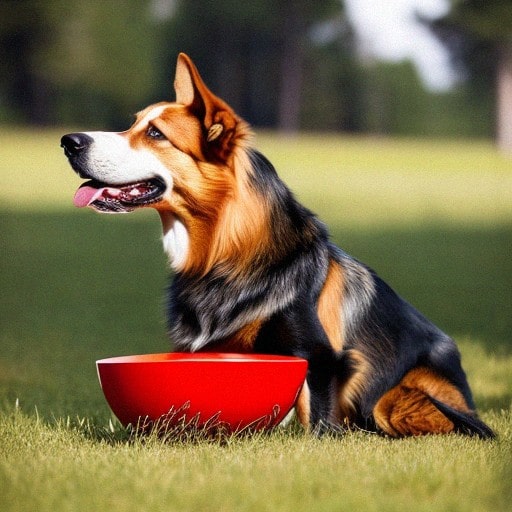Dogs are man’s best friend, and as such, it is our responsibility to ensure that they are well-nourished and healthy. One of the best ways to keep our furry friends healthy is by feeding them high-quality dog food.
With so many different types of dog food on the market, it can be challenging to determine which is the best for your dog. In this article, we will explore the best types of dog food available to help you make an informed decision.
Dry Dog Food: A Classic Choice
Dry dog food is the most common type of dog food on the market. And it has been a popular choice for many years. Moreover, it is a great choice for many pet owners because it is easy to store, easy to serve, and it is cost-effective. Many brands of dry dog food offer a balanced and nutritious diet that provides all the essential nutrients that your dog needs.
One of the most significant benefits of dry dog food is that it helps to maintain your dog’s dental health. The act of chewing the kibble helps to clean your dog’s teeth, preventing the buildup of plaque and tartar. Additionally, dry dog food can help to control your dog’s weight as it is low in fat and high in fiber.

Wet Dog Food: For Dogs Who Love Moisture
Wet dog food is another popular choice for pet owners, particularly those with dogs who prefer moist food. Unsurprisingly, wet dog food contains a higher moisture content than dry food, making it an excellent choice for dogs who need to increase their water intake.
Wet dog food is typically more expensive than dry food, and it is not as convenient to store. It also has a shorter shelf life than dry dog food, so it must be used within a few days of opening.
One of the benefits of wet dog food is that it is often more palatable than dry dog food. This can be particularly helpful for dogs who are picky eaters or those who have a diminished sense of smell. Additionally, wet dog food can be easier to digest for some dogs.
Raw Dog Food: A Natural Choice
Raw dog food is a relatively new type of dog food that has gained popularity in recent years. This type of dog food is made from raw meat, fruits, and vegetables, and it is designed to mimic a dog’s natural diet in the wild.
Raw dog food can be more expensive than other types of dog food, and it requires careful handling to ensure that it is safe to eat. Additionally, there is some controversy over the safety of raw dog food, as it can be a source of harmful bacteria.
However, proponents of raw dog food argue that it provides a range of benefits, including improved dental health, shinier coat, and increased energy levels. If you are considering raw dog food, it is essential to do your research and consult with a veterinarian.
———————-ADVERTISEMENT———————-
Homemade Dog Food: A Personalized Option
Homemade dog food is another popular option for pet owners who want to ensure that their dog’s diet is tailored to their specific needs. With homemade dog food, you have complete control over the ingredients, which can be particularly helpful for dogs with food allergies or sensitivities.
However, it is essential to ensure that your homemade dog food provides a balanced diet that includes all of the essential nutrients that your dog needs. Additionally, it can be time-consuming to prepare homemade dog food, and it can be more expensive than other types of dog food.
Grain-Free Dog Food: For Dogs with Food Sensitivities
Grain-free dog food has become increasingly popular in recent years, particularly for dogs with food sensitivities or allergies. Like the name suggests, grain-free dog food is made without grains such as wheat, corn, or soy, which can be difficult for some dogs to digest.
However, it is important to note that not all dogs require grain-free dog food, and there is some debate over whether or not it provides any significant health benefits. It is always best to consult with a veterinarian before making any changes to your dog’s diet.

Limited Ingredient Dog Food: For Dogs with Allergies
Limited ingredient dog food is another type of dog food that is designed for dogs with food allergies or sensitivities. This type of dog food contains a limited number of ingredients, typically one protein source and one carbohydrate source, to minimize the risk of an allergic reaction.
Limited ingredient dog food can be more expensive than other types of dog food, and it may not be suitable for dogs who require a more varied diet. However, if your dog has food allergies or sensitivities, limited ingredient dog food can be an excellent choice to help manage their condition.
Senior Dog Food: For Aging Dogs
As dogs age, their nutritional needs change, and they may require a different type of dog food to maintain their health. Senior dog food is specially formulated to provide the nutrients that aging dogs need to stay healthy and active.
Senior dog food is typically lower in calories and fat than other types of dog food, as older dogs tend to be less active and have slower metabolisms. Additionally, senior dog food often contains supplements such as glucosamine and chondroitin, which can help to maintain joint health.
———————-ADVERTISEMENT———————-
Puppy Dog Food: For Growing Pups
Puppy dog food is another type of dog food that is formulated to meet the nutritional needs of growing puppies. Puppies require a diet that is high in protein and fat to support their rapid growth and development.
Puppy dog food is typically higher in calories than adult dog food, and it contains additional nutrients such as calcium and phosphorus to support healthy bone development. It is essential to feed your puppy a high-quality puppy food until they reach maturity, which is typically around 12 months of age.
Prescription Dog Food: For Dogs with Health Issues
Prescription dog food is a type of dog food that is specially formulated to meet the nutritional needs of dogs with specific health conditions. This type of dog food is available by prescription only and is typically sold through veterinary clinics.
Prescription dog food can be more expensive than other types of dog food, but it can be an essential part of managing certain health conditions such as kidney disease, diabetes, or obesity. If your dog has a specific health condition, it is essential to consult with your veterinarian to determine if prescription dog food is necessary.

High-Protein Dog Food: For Active Dogs
High-protein dog food is a type of dog food that is designed for active dogs who require a high-energy diet to support their active lifestyle. This type of dog food typically contains a higher percentage of protein than other types of dog food.
High-protein dog food can be more expensive than other types of dog food, and it may not be suitable for all dogs. However, for active dogs who require a high-energy diet, high-protein dog food can be an excellent choice to support their active lifestyle.
Final Thoughts
In conclusion, there are many different types of dog food available on the market, each with its unique benefits and drawbacks. When choosing a type of dog food for your furry friend, it is essential to consider their nutritional needs, their age, and any health conditions they may have.
Whether you choose dry dog food, wet dog food, raw dog food, homemade dog food, grain-free dog food, limited ingredient dog food, senior dog food, puppy dog food, prescription dog food, or high-protein dog food, the most important thing is to ensure that your dog’s diet provides all of the essential nutrients they need to stay healthy and happy. By taking the time to choose the right type of dog food and monitoring your dog’s health, you can help ensure that they live a long and healthy life by your side.
Remember, it is always important to consult with your veterinarian before making any significant changes to your dog’s diet. Your veterinarian can help you determine the best type of dog food for your furry friend based on their individual needs and circumstances.
At the end of the day, the best type of dog food is the one that meets your dog’s nutritional needs, is easy to serve and store, and that your dog enjoys eating. By taking the time to choose the right type of dog food, you can help ensure that your furry friend stays healthy, active, and happy for years to come.
